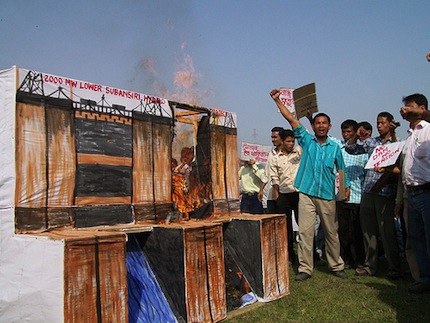Farmer and social activist Oyar Gao, general secretary of Siang People’s Forum, becomes emotional when he talks about Siang Ane or Siang Mother. He, and everybody around him, consider the Siang – as the main stem of the Brahmaputra River is called in Arunachal Pradesh – to be holy. He grew up swimming and fishing on its banks.
“I speak the truth and only the truth when I talk about river Siang. We will not allow a big dam to be built over this holy river at any cost,” said Gao, who lives in Pangin, 75 km upstream of Pasighat in East Siang district of the state of Arunachal Pradesh, high in the Himalayas in the north-eastern corner of India.
China also claims the entire 83,473 sq km of the state, calling it Southern Tibet. The 2011 census put the population at 1.38 million. That claim, and the fact that China is building dams further upstream in Tibet – where the river is called the Yarlung Zangbo – has spurred the dam-building plans of India.
Gao has been engaged in a movement to oppose the building of the mega dams on the river Siang since 1980. On September 14 and 15 this year, people came together from all the Banggos of Upper Siang and dam affected part of East Siang district for a two day meeting at Yingkiong in Upper Siang district. A Banggo is a tribal council of multiple villages.
Most of those who attended the meeting vehemently opposed the construction of dams on the Siang. Once the Siang comes down from the Himalayas and enters the Assam valley at Pasighat, it is joined by two other large rivers, the Dibang and the Lohit to form the Brahmaputra.
After entering Arunachal Pradesh near Gelling, the Siang flows 294.5 km down the Himalayas before its confluence with Dibang and Lohit. Three hydroelectric projects are planned on this stretch – the 6,000 MW Upper Siang Stage I, the 3,750 MW Upper Siang Stage II and the 2,700 MW Lower Siang. The website of the Department of Power in the state government of Arunachal Pradesh states, “Our mission is to make Arunachal Pradesh the ‘Power House of INDIA’, with a dream to provide every rural household of our state with FREE electricity round the clock.”
Vijam Taram, an environmental activist, sounds angry when he talks of the proposed dams on the Siang. “The Upper Siang Stage-I dam is slated to be the biggest dam in the country. The project will devastate human lives and biodiversity of both districts by inundating all forest and agriculture lands. The dams, if completed, will flood all fertile agricultural lands, destroy ecology, flora and fauna of entire Siang belt and displace thousands of people of Siang valley.”
Many historical places will also be submerged if the dams are built. Kekar Monying, located near Rottung in Lower Siang, is a mountain cliff that has a significant place in the history of the Indian freedom struggle. In 1911, the Adi tribe began massive opposition against British rule here. Gao says, “We will lose this historic site as it will be submerged by the dam.”
The meeting resolved to form an ‘anti-dam core committee’ to be called Siang Indigenous Farmers Forum (SIFF) which will take up all matters related to dams on the Siang with the state and central governments. Taram says, “When we can give 33 dams to the nation, why can’t the Government of India grant us three dams on Siang? We have 151 mega dams in the state, among that we have 36 dams in the belt dominated by the Adi tribe and out of this 36 we are not opposing 33, but only three. Why can’t the government spare us three dams? The paddy fields are the lifeline of the farmers and all the residents are agriculturists.” A total of 151 small, medium and large dams are planned in the state.
Gao says the Stage II dam on Upper Siang will totally submerge the biggest tea garden in Arunachal Pradesh – Moling Tea Garden, famous for its green tea. People downstream of the proposed project are worried too. Gao says locals believe disaster will strike if “Mother Siang” goes dry.
Many local leaders, including Gegong Apang, former chief minister of Arunachal Pradesh, attended the meeting and resolved to oppose the construction of the dams tooth and nail.
Teresa Rehman is managing editor, www.thethumbprintmag.com
